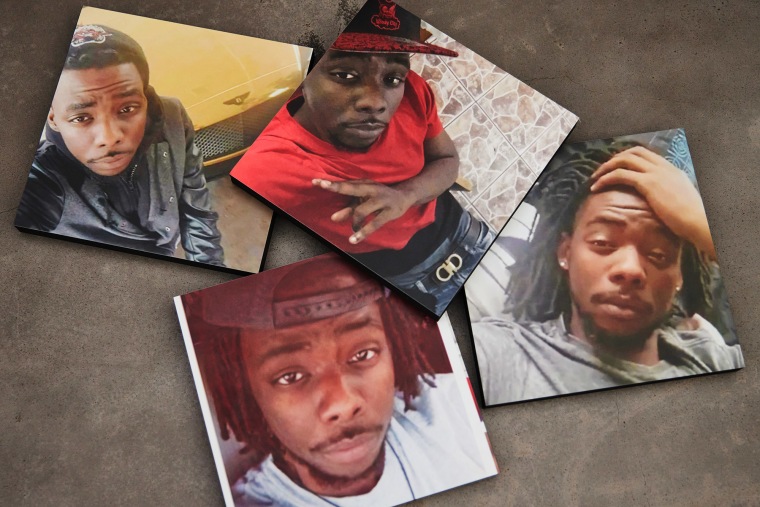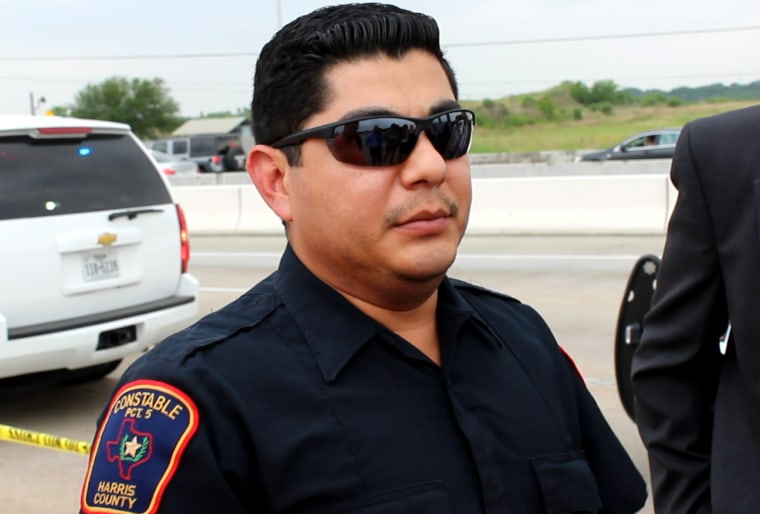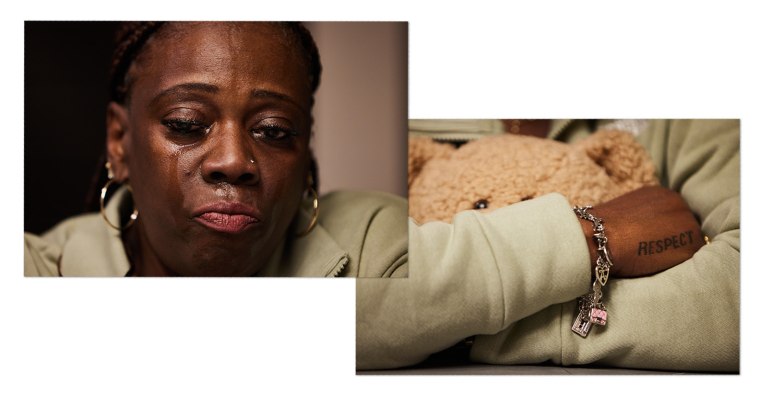HOUSTON — It took just seconds for a routine traffic stop on a Texas highway to escalate into a fatal shooting that left 24-year-old Ashtian Barnes bleeding to death in the driver’s seat.
What happened during those seconds and the minutes prior during the April 2016 incident is now central to a Supreme Court case being argued on Wednesday that could make it easier — or harder — to hold police officers accountable for the use of excessive force.
For Barnes’ mother, Janice Hughes, 55, who filed the civil rights lawsuit at the center of the case, the oral argument at the high court is the latest stop on a more than eight-year quest for justice on behalf of her only son, who was a Black man.
“I want out of this that my son was a victim. He was never a suspect … and I need that to be clear. He was a victim from the very beginning,” she said in an emotional interview at her lawyer’s home in Houston with her two daughters and granddaughter by her side.
Almost five years since the death of George Floyd, another Black man killed by a police officer, Hughes believes no progress has been made despite the mass protests and calls for social justice that followed.
“I feel like at some point, somebody has to really take this seriously, because it continues to happen and all we get to do is rally, and ‘Black Lives Matter,’ and nothing changes,” Hughes said. “Nobody’s policing the police.”
Hughes’ civil rights lawsuit was dismissed by lower courts on the grounds that no excessive force was used.
But the courts made that assessment based only on the precise moment that force was used, based on a precedent adopted in parts of the country but not to date embraced by the Supreme Court.
Hughes’ lawyers are now asking the Supreme Court to reject what has been dubbed the “moment of the threat doctrine,” which could lead to a nationwide ruling that makes clear courts should consider events leading up to the use of force when assessing an officer’s conduct.

‘Moment of the threat’
Barnes was driving a rented silver Toyota Corolla, which his girlfriend had booked, on the Sam Houston Tollway in west Houston when the incident took place at 2:45 p.m. on April 28, 2016. He was on his way to pick up his girlfriend’s daughter from school, according to Hughes.
Roberto Felix Jr., a traffic enforcement officer with the Harris County Precinct 5 Constable’s Office, which is a local police department, received a report that Barnes’ car had outstanding toll violations.
He pulled the vehicle over to the left on the median side of the southbound tollway and approached the driver’s side. Barnes initially could not produce his license or proof of insurance and told Felix the documents might be in the trunk. At the time, Felix said he smelled marijuana, although no evidence of any drugs was found in the car. During those initial moments, Barnes turned off the engine and removed the key from the ignition.
The fast-moving sequence of events lasted just seconds and was captured on video filmed from Felix’s patrol car, leaving exactly what transpired in the vehicle out of sight.
Felix asked Barnes to exit the car. But almost as soon as the car door was opened, according to Felix’s deposition in the case, Barnes quickly put the key in the ignition, started the engine, and put the car in drive. The vehicle started to move forward. Felix stepped onto the door sill and shouted at Barnes not to move. He then fired his firearm twice, hitting Barnes in the torso, and the vehicle quickly stopped.
Barnes died at the scene.

The Houston Police Department, which is separate from the constable’s office, and the Harris County District Attorney’s Office investigated the killing, with a grand jury finding no probable cause to bring criminal charges.
Felix, who has been a police officer since 2004, was involved in another fatal shooting in 2007, according to testimony he gave to a grand jury investigating Barnes’ death. Jeff McShan, a spokesman for the police department, said Felix still works there and has not been disciplined as a result of the Barnes incident. A review of the shooting found it was justified, he added.
“They didn’t find anything wrong with what he did,” McShan said.
Felix, via his lawyers, declined to comment.
In his deposition, Felix said that although it had initially appeared to be a routine traffic stop, his view changed because of what he interpreted as Barnes’ suspicious behavior, such as not having his license and rummaging around the car looking for the rental car agreement.
“His actions kept indicating to me that he was up to something,” Felix said in the deposition. (At the time of the incident, Felix did not see any signs that Barnes was armed, although a gun was later found in the vehicle.)
When Barnes restarted the engine and tried to put the car in gear, Felix said he feared for his safety, which is why he jumped on the door sill and then fired his weapon.
“It must have been maybe two, three seconds, possibly,” Felix said. “At that moment it felt like it was longer than that, though.”

National significance
In Hughes’ lawsuit, she claims Felix used excessive force in violation of the Constitution’s Fourth Amendment, which prohibits unlawful searches and seizures. She also filed a separate claim against the police department, which is not directly at issue before the Supreme Court.
Her lawyers say Felix could have avoided using deadly force by de-escalating the situation and argue that he violated police department policies on the use of force.
The dispute reached the high court after Judge Patrick Higginbotham of the New Orleans-based 5th U.S. Circuit Court of Appeals, which hears cases arising from Texas, reluctantly authored a decision in favor of Felix. He wrote that he was bound to follow the court’s own precedents, but he all but pleaded for the Supreme Court to intervene.
Most notably, Higginbotham concluded that if he weren’t bound by the “moment of the threat” doctrine and were able to evaluate a broader array of evidence, he would have concluded that a constitutional violation had taken place.
“Here, given the rapid sequence of events and Officer Felix’s role in drawing his weapon and jumping on the running board, the totality of the circumstances merits finding that Officer Felix violated Barnes’s Fourth Amendment right to be free from excessive force,” he wrote.
Texas-based District Judge Alfred Bennett had similar concerns when he ruled in March 2021 that based on the appeals court precedent, no constitutional violation occurred.
Like Higginbotham, Bennett criticized the appeals court’s approach, saying that it had “effectively stifled a more robust examination of the Fourth Amendment’s protections when it comes to encounters between the public and the police.”
It is already extremely difficult to mount a successful lawsuit against police officers alleging excessive force. How the court rules will not drastically change the legal landscape in that regard, but it will nevertheless have national significance.
That is because the 12 regional federal appeals courts are divided, with four embracing the “moment of the threat doctrine” and eight rejecting it, according to Hughes’ lawyers. If the court rules for Hughes, the doctrine would be voided nationwide, constituting a loss for police officers accused of excessive force. But if the court rules for Felix, it could make it even harder for plaintiffs to bring such claims.

Felix’s lawyers say that lower courts are not as divided on the issue as Hughes’ legal team has argued. They say the approach taken by the 5th Circuit was consistent with how the Supreme Court has directed lower courts to address excessive force claims, including under a 1989 case called Graham v. Connor.
The Supreme Court said in that case that when determining whether excessive force was used, courts have to view the incident from the perspective of what an “objectively reasonable” officer would have done in the same situation.
In essence, the dispute boils down to what exactly the Supreme Court meant in the 1989 case, building on a ruling from four years earlier when it said courts should consider the “totality of the circumstances” in assessing an officer’s actions. Hughes’ lawyers say that should include the sequence of events leading up to the use of force, while Felix’s say it should be limited to the exact moment the officer decided to use force.
A more expansive consideration of the preceding moments would in some cases give plaintiffs a better chance to show that the officer’s conduct was unreasonable, thereby allowing a lawsuit to move forward.
Qualified immunity
Even if Felix loses at the Supreme Court, he still has a good chance of prevailing on the excessive force claim. That’s because he could invoke the qualified immunity defense, which courts have increasingly used to shield police officers in similar cases. The defense applies when a constitutional violation takes place but the officer was not on notice that the alleged conduct was unlawful. Courts would have to take a second look at the Barnes case to see if it was “clearly established” at the time of the incident that Felix’s actions violated the Constitution.
Felix’s lawyers maintain that he would be protected under appeals court precedents.
“Felix is entitled to qualified immunity under the clearly established law in effect at the time he stopped Barnes,” they wrote in court papers.
But as Hughes’ lawyers point out, even if she ultimately loses, she might still be able to obtain a ruling from a lower court that puts cops on notice that conduct like Felix’s is unconstitutional going forward. That could alter police training, helping to prevent similar incidents from happening, and would mean that officers would not be protected by qualified immunity in future cases involving the same type of conduct.

A win for Hughes would be of “symbolic and material significance,” according to Clark Neily, a lawyer at the libertarian Cato Institute, which filed a brief backing her. The court would have removed a barrier to Hughes and other plaintiffs in affected parts of the country either getting their cases in front of a jury or obtaining a settlement, he added.
The Biden administration filed an amicus brief partly backing Hughes, in which Solicitor General Elizabeth Prelogar wrote that any assessment of an officer’s use of force “should not categorically disregard prior officer conduct.”
But she said that because officers have to make “split-second judgments in defending themselves and the public from danger,” the moment that force was used “will generally have primary significance.”
Typically, the federal government backs law enforcement officers in such cases. The case is being argued at the court two days after President Joe Biden leaves office, to be replaced by Donald Trump, who has been more supportive of police using force.
Sitting at her lawyer’s dining table with photos of her son spread out in front of her, Hughes said it was a “hallelujah moment” when she heard the Supreme Court was taking up the case because it puts her story in the national spotlight.
Both she and Felix are expected to be in attendance at the oral arguments. A ruling is likely by the end of June.
Barnes had encountered police officers before and had faced jail time for marijuana-related offenses, but Hughes remembers him as a “really charismatic, fun guy” who was a huge sports fan and liked playing video games.
With tears rolling down her face, Hughes spoke while cradling a stuffed bear wearing a Houston Rockets shirt. When a button is pressed, it plays an audio clip of Barnes teaching one of his sisters how to do a dance called the Tootsie Roll.

The bear was given to her on her 50th birthday to remind her of her son.
“That’s the voice I have to keep, and that’s the voice I got. So periodically I just get up and push the button,” she said. “It’s been eight long years. I mean, we still have to live life, and we do it the best way we can, with each other.”

